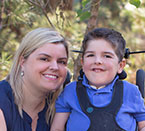United Front
Connected through social media, two alums bring awareness to spinal muscular atrophy.

Shannon Scott Zerzan '01 with son Charlie. (photo courtesy of Shannon Zerzan)
United Front
Connected through social media, two alums bring awareness to spinal muscular atrophy.
Former TCU classmates Shannon Scott Zerzan ’01 and Crystal Hecker Somers ’01 recently reconnected through social media. Their budding friendship sprang from a shared struggle.
Zerzan and Somers have young sons with spinal muscular atrophy, a genetic disease that affects the part of the nervous system that controls voluntary muscle movement. Each year between 1 in 6,000 and 1 in 10,000 people are born with the disease, which is classified into four types based on age of onset and achievement of the highest physical milestone, report the U.S. National Library of Medicine and the National Human Genome Research Institute.
“Our shared experience allows us to understand each other in a profound way.”
Shannon Zerzan
“I hate that Shannon’s family has to deal with SMA,” said Somers, who lives in Humble, a Houston suburb. “But having a fellow Horned Frog I can turn to with questions, concerns or just to vent makes it so easy because we are already part of the TCU family. Now, we are part of the SMA family as well.”
Zerzan, who lives in Alexandria, Va., reached out to Somers a year ago when a mutual friend realized that both mothers were posting about the condition on Facebook. Eventually, the two women became close and found their mutual support invaluable.
Zerzan’s son Charlie was diagnosed in early 2010, a few months after his second birthday. “When he was about 18 months old, we noticed he was having trouble doing things at our neighborhood park that he had previously been able to do.”
Charlie developed an awkward gait. His running slowed and climbing stairs became an ordeal. A neurologist concluded that Charlie was dealing with a neuromuscular disorder, Zerzan said. “To say we felt as though we had been punched in the gut is an understatement.”
Doctors diagnosed Charlie with Type 3, the rarest and mildest form of the childhood onset of the disease. His younger brother, George, does not have the condition.
Charlie participates in a clinical trial for a drug designed to treat the disease and remains healthy, Zerzan said. “He walks and runs (a little) and plays and is very familiar with the challenges placed on him by the condition.”
While Charlie tires easily, Zerzan said he makes it through most school days without using a motorized scooter. With the help of physical therapy, he has become an avid swimmer.

Crystal Hecker Somers with son Cooper. (photo courtesy of Crystal Somers)
Somers’ son, Cooper, was 4 months old when she and her husband, Jason, noticed an issue with his legs. His pediatrician downplayed the impaired movement, but a second opinion from a different pediatrician confirmed their concerns.
“Having a fellow Horned Frog I can turn to with questions, concerns or just to vent makes it so easy because we are already part of the TCU family. Now, we are part of the SMA family as well.”
Crystal Somers
An initial blood test indicated that Cooper had Type 1, the most severe form of the disease.
“His pediatrician told us to take him home and love him because he could live two weeks, two months, two years,” Somers says. “Thank goodness he has fought the odds, and he has made it much longer than expected.”
Somers says that Cooper’s doctors now consider him either a weak Type 2 or strong Type 1. He also has frequent, dangerous respiratory illnesses. In December 2012, he had pneumonia. While Cooper was in the hospital, Somers’ husband died in a car accident.
To honor her husband’s wishes, Somers enrolled their son in a public school kindergarten last year. During the school day, a nurse attends to Cooper’s needs. He gets twice-weekly physical therapy plus speech and occupational therapy sessions. At home, an assortment of medical devices helps the young boy breathe more easily. During the night, Somers must turn her son every few hours to prevent bedsores.
Yet Cooper is an active child. He participated in a special-needs baseball league in the spring, and he plays in a power chair soccer league. He also enjoys his role as big brother to Hunter, who was born after the death of Somers’ husband through in vitro fertilization with genetic screening.
Zerzan and Somers are devoted to raising awareness and hope about their sons’ genetic conditions. Zerzan and her husband, Greg, organized a Hope on the Hill congressional dinner in 2011. The annual event has raised more than $800,000 for Cure SMA, a national nonprofit organization focused on advocacy, support and research.
The Somers family is active in muscular dystrophy causes. In 2013, Cooper was featured on the Muscular Dystrophy Association’s annual telethon and served as an ambassador for the organization. Nowadays his mother works with other Houston-area mothers to organize a future fundraiser to support Cure SMA.
Somers and Zerzan plan to continue supporting each other.
“Our shared experience allows us to understand each other in a profound way,” Zerzan said. “Having a surplus of purple in our wardrobes is icing on the cake.”

Your comments are welcome
1 Comment
Thank you for the information.
Related reading:
Features
Politics 101
Students appraise the political landscape
Alumni
Exhibiting Talent
Andrea Karnes ’01 MA found her calling ― and the rest is art history.